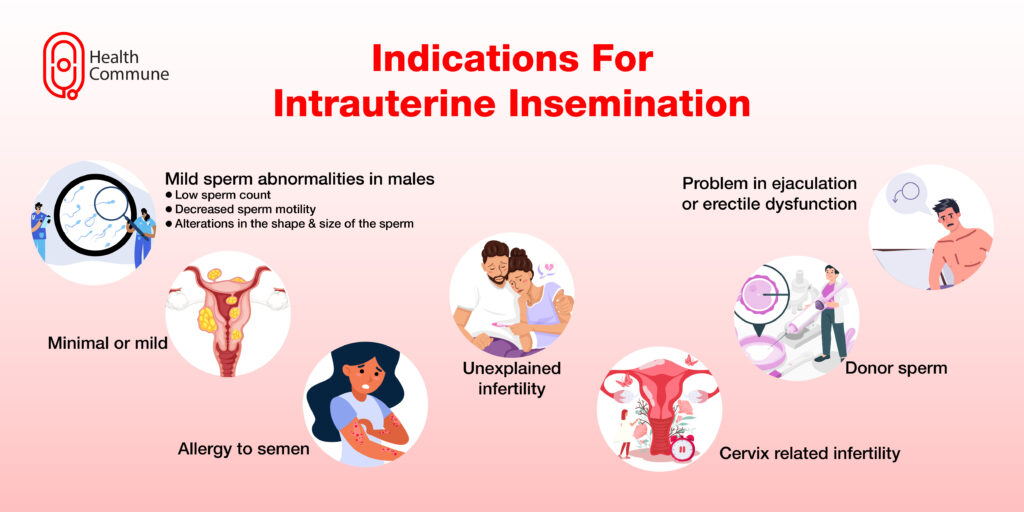What is intrauterine insemination (IUI)?
IUI is a type of artificial insemination and a simple fertility treatment that can be a starting point for couples who are having difficulty conceiving. Here, washed and concentrated sperm are placed directly inside the uterus during ovulation to facilitate conception.
In natural conception, the sperm travel from the vagina, through your cervix, into your uterus, and then to the fallopian tube. The egg released by your ovaries travels to the fallopian tube as well. The sperm meets the egg here, and fertilisation happens.
The purpose of IUI is to increase the number of sperm in your fallopian tube to maximise the chances of conception. In many cases, IUI is a better, cheaper, and easier option for you to try before you attempt advanced procedures.
What are the indications of IUI?
- Mild sperm abnormalities in males
- Low sperm concentration
- Decreased motility of the sperm
- Alterations in the shape and size of the sperm
- Problems in ejaculation or erectile dysfunction
- Allergy to semen (in rare cases, allergy to proteins in the semen may necessitate the use of condoms which in turn prevents pregnancy)
- Unexplained infertility
- Cervix-related infertility: thick mucous that prevents sperm movement and scarring of the cervix
- Donor sperm
- Minimal or mild endometriosis
What are the contraindications of IUI?
- Severe male infertility
- Blocked fallopian tubes
- Endometriosis
- Cervical atresia (deformed or non-functional cervix)
- Cervicitis
- Amenorrhea

What happens during the IUI treatment process?
The timeline for the IUI procedure is approximately 28 days. On the day of insemination, either your partner gives a semen sample or a donor’s frozen semen is thawed and prepped. The semen is washed to remove proteins and any low-quality sperm.
The procedure takes a few minutes and does not involve anaesthesia. Your fertility specialist will clean your cervix and, with the help of a small catheter, insert a drop of washed, concentrated sperm into your uterus. It is not a painful procedure but might cause mild cramping. You may be advised to rest in bed for a day.
IUI is often combined with medicines that promote ovulation. These medicines stimulate your ovaries to release more eggs and increase the chances of fertilisation.
What happens after the IUI procedure?
You can take an at-home pregnancy test two weeks after the procedure. Testing too soon can result in false results. You will be advised to take a blood test two weeks after a positive home test to confirm pregnancy.
What are the risks of IUI treatment?
- Infections
- Mild spotting : Due to the insertion of a catheter into your vagina, there is a chance of mild vaginal bleeding. This does not affect your chances of pregnancy
- Multiple pregnancy : IUI is highly likely to result in multiple pregnancies when combined with ovulation-inducing medications, meaning you may have twins, triplets, or more children
What happens if IUI is not successful?
What is donor insemination (DI)?
IUI can also be performed using donor sperm, which you could obtain from an anonymous source at the semen bank. Donor insemination is mostly used if you don’t have a male partner, if your male partner does not produce high-quality sperm, or if there is a risk of passing on a genetic disease.
Before you agree to use donor sperm, it is important to understand how you and your partner feel about it.
What is the success rate of IUI?
According to a study, age plays a vital role in the treatment of IUI. For women under the age of 40, three IUI cycles are recommended before moving forward with IVF treatment. The success rate of IUI per cycle is about 16.4% for the first three times. The success rates are seen to show a decline after three times. This is why IVF is recommended after three cycles of IUI.
For women above the age of 40, low pregnancy rates are observed. Therefore, it’s the best decision to move directly to IVF treatment in such cases.
What is the difference between IUI and IVF?
In IUI, the fertilisation of the egg happens inside the body in the fallopian tube. In IVF, fertilisation happens in the lab and the embryo is then implanted into the uterus for further development. When compared to IVF, IUI is less invasive and cheaper as well. However, success rates are lower with IUI.





